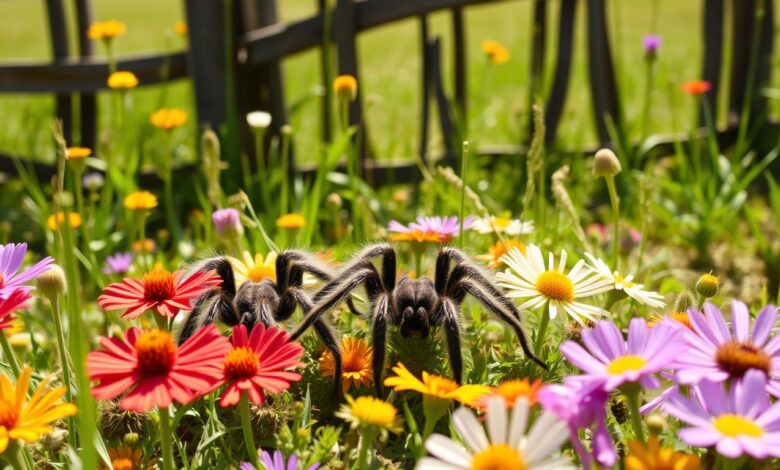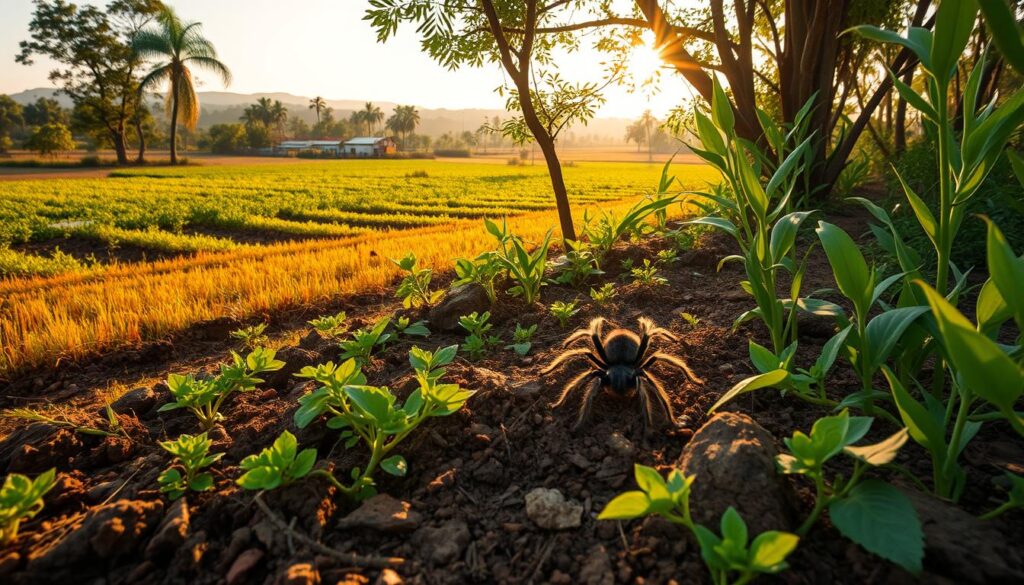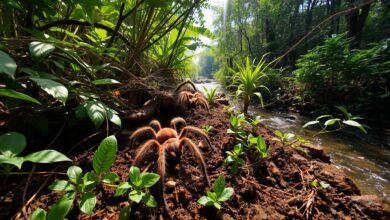Adaptations of tarantulas to rural and agricultural environments

Have you ever thought about how tarantulas live in different rural areas around the world? Tarantulas are more than just scary creatures. They are important for rural and agricultural ecosystems. They have special adaptations that help them live in these places.
In this article, we’ll look at how tarantulas adapt to rural life. We’ll talk about where they live, their favorite places, and their role in nature. We’ll also explore how their venom can help rural areas and farms. Get ready to learn about the amazing skills of these spiders.
Introduction to Tarantulas in Rural Environments
Tarantulas are fascinating spiders found in many rural and agricultural areas worldwide. They are known for their large size and unique looks. These spiders are important in rural ecosystems, playing a key role in their balance.
Tarantula Species Distribution in Rural Areas
There are many tarantula species, each suited to different rural habitats. They live from South America’s lush forests to the dry deserts of the southwestern United States. This wide spread helps them keep rural ecosystems healthy by controlling pests and cycling nutrients.
Environmental Impact of Tarantulas on Rural Ecosystems
Tarantulas have both good and bad effects on rural ecosystems. They help control pests, which is good for crops and livestock. Their eating habits also keep the food web balanced.
But, large tarantula populations can upset the balance in rural areas. This can lead to problems with human activities and harm sensitive habitats.

It’s important to understand how tarantulas and their environments interact. This knowledge helps create plans that protect these spiders and meet the needs of local communities.
Tarantulas as Biological Pest Control in Agriculture
Tarantulas are now seen as key players in fighting pests in farms and rural areas. They eat many pests like insects, rodents, and small animals that harm crops. By living in farms, farmers can cut down on harmful pesticides and use nature to control pests.
Role of Tarantulas in Controlling Agricultural Pests
Tarantulas are great at eating pests that bother farms. They eat insects like grasshoppers and beetles, and even small rodents. This helps keep pests in check and lowers the need for harmful chemicals.
Having tarantulas around can really help farms stay healthy and productive. They keep pests away from crops, making farming more sustainable. This way of fighting pests is good for the planet and saves farmers money.
| Pest Controlled | Tarantula Impact | Benefit to Agriculture |
|---|---|---|
| Insects (e.g., grasshoppers, crickets, beetles) | Tarantulas are voracious predators that can help control insect populations that threaten crops. | Reduced crop damage and increased yields. |
| Rodents (e.g., mice, voles) | Tarantulas are effective hunters of small rodents that can burrow and damage root systems or stored crops. | Safeguarding crops and stored harvests from rodent infestations. |
| Other small animals (e.g., snakes, lizards) | Tarantulas are apex predators in their local ecosystems, helping to maintain a balanced food web and control populations of other small animals that may threaten crops. | Promoting a healthy, diverse ecosystem that supports sustainable agriculture. |
Farmers can help tarantulas by making their farms a good place for them. This natural way to fight pests is good for crops and helps the environment. It also makes farming more sustainable.

Habitat Preferences of Tarantulas in Rural Settings
Tarantulas are fascinating spiders that live in many rural places around the world. They can be found from the pine savannas in the southern United States to the green forests of Central America. These spiders have made many rural areas their home.
Climate plays a big role in where tarantulas live in rural areas. Tarantulas in rural environments live in places with different temperatures, from the hot, humid tropics to cooler areas. They can control their body temperature to stay active, no matter the spider habitats.
The type of plants around also affects tarantulas in rural areas. Some like the thick forests of the tropics, while others do well in open pine savannas. They use plants for shelter, to make nests, and to catch their food.
| Habitat Type | Tarantula Species Commonly Found | Adaptations |
|---|---|---|
| Pine Savannas | Aphonopelma spp. | Ability to withstand fluctuating temperatures, preference for open canopy |
| Deciduous Forests | Brachypelma spp. | Adaptations for navigating dense understory, camouflage coloration |
| Tropical Grasslands | Poecilotheria spp. | Agility for hunting in open spaces, tolerance for high temperatures |
Knowing what tarantulas like in rural areas is important for their protection. By understanding what draws them to certain places, scientists can help protect and manage their populations better.
Adaptations of Tarantulas for Survival in Rural Habitats
Tarantulas live in rural and agricultural areas and have evolved many ways to survive. They have strong bodies and sharp fangs for catching prey. They can also hide underground and sense their surroundings to avoid danger.
Physical and Behavioral Adaptations
Tarantulas have amazing physical traits. Their tough shells and strong fangs let them easily catch food. They can dig and hide, and their senses help them find food and move around safely.
They also have smart behaviors. Tarantulas dig complex tunnels and dens for shelter. They can hide and hunt quietly, making it hard for others to find them.
Venom Research and Tarantula Adaptations
Scientists are studying tarantula venom because it could be useful for medicine and controlling pests. Research shows that some tarantulas’ venom can kill insects and reduce pain. This could lead to new ways to fight pests and help people.
Learning about tarantulas’ survival skills helps us understand their role in nature. This knowledge can help protect them and improve how we use land. It could also lead to new uses for their venom.
Tarantulas in rural environments
Tarantulas are fascinating and often misunderstood creatures of the countryside. They live in many places, from pine savannas to tropical grasslands. Their ability to adapt shows how important they are to their ecosystems.
In rural areas, tarantulas help control pests by eating small insects. They are key to keeping the balance in nature. By learning about their lives, we see how they connect with their environments.
- Tarantulas are found in a wide range of rural habitats, from pine savannas to tropical grasslands.
- These spiders play a vital role as predators, helping to control populations of agricultural pests and maintain the balance of rural ecosystems.
- Studying the adaptations and habitat preferences of tarantulas can provide valuable insights into the intricate relationships within rural environments.
As rural and agricultural areas change, we must think about how this affects tarantulas and their homes. Protecting their habitats helps keep rural ecosystems healthy. This is good for local communities too.
Ecosystem Dynamics and Tarantula Populations
Tarantulas are key players in the complex world of rural and agricultural ecosystems. They are deeply connected to the balance of their environments. Their numbers and actions change with different environmental factors. When rural areas change, like through deforestation, becoming more urban, or new species arrive, tarantulas’ homes can be greatly affected.
Impact of Environmental Changes on Tarantula Habitats
Changes in the environment can greatly affect tarantulas in rural areas. Things like climate change, habitat fragmentation, and invasive species can upset the balance of their homes. It’s important to know how different tarantula species adapt and what they need. This helps us understand how environmental changes affect them and how to protect them.
Doing detailed environmental impact assessments is key to seeing how new projects or land use changes might affect tarantulas and their homes. These assessments spot which species are at risk, important paths for them, and ways to lessen harm. This helps keep tarantula communities safe in rural areas.
Understanding the important role of tarantulas in arachnid ecology and spider habitats helps researchers and policymakers. They can create conservation plans that meet human needs and protect these amazing creatures.
Biodiversity Conservation and Tarantula Species
Tarantulas are key to the biodiversity in rural and agricultural areas. They help keep these ecosystems balanced and resilient. But, threats like habitat loss, pesticide use, and climate change threaten their survival and conservation.
Threats to Tarantula Populations in Rural Areas
Habitat loss is a big threat to tarantulas in rural areas. As land is taken for farms or cities, their homes get smaller. This forces them to adapt or disappear. Pesticides used in farming also harm tarantulas, hurting their numbers.
Climate change is another big threat. Changes in weather and extreme events can change tarantula habitats and harm their ecosystems. This can lead to fewer tarantulas and even extinction.
| Threat | Impact on Tarantula Populations |
|---|---|
| Habitat Loss and Fragmentation | Reduced available living space, increased competition, and potential local extinctions |
| Pesticide Use | Direct toxicity, disruption of food webs, and overall ecosystem imbalance |
| Climate Change | Alterations in temperature, precipitation, and extreme weather events, leading to habitat changes and population declines |
We need a plan to protect tarantulas in rural areas. This plan should include saving their homes, farming safely, and more research and teaching. By valuing these arachnid ecology and acting, we can keep rural ecosystems diverse for the future.
Educational Initiatives on Tarantulas in Rural Communities
Teaching rural folks about tarantulas is key to saving them and making them part of local life. With school programs, community events, and public campaigns, people can learn about these spiders’ special traits and roles. This knowledge helps overcome myths and fears, making it easier for humans and tarantulas to live together in the countryside.
Such programs have shown success by making rural communities value and protect their tarantulas. They learn to see these spiders as friends, not foes.
- School programs with tarantula lessons and activities spark students’ interest and teach them about these spiders’ importance.
- Community events like workshops or nature walks let people see and learn about tarantulas up close.
- Public awareness campaigns on social media and local media help clear up wrong ideas and show how tarantulas help the environment.
These efforts do more than just save tarantulas. They also build a sense of care and community spirit in rural areas. By teaching people to love and protect tarantulas, these programs help make rural places more sustainable and full of life.
Environmental Impact Assessment and Tarantula Habitats
It’s key to do environmental impact assessments to understand how human actions affect tarantula habitats in rural and farm areas. These assessments spot the needs and weak spots of tarantulas. They also look at how new projects or changes in land might hit them.
By thinking about tarantulas and other wildlife when making decisions, we can use environmental impact assessments to support sustainable ways. This helps keep tarantula habitats safe and lets humans and these arachnids live together in rural places.
When looking at tarantula habitats, we should think about:
- What spider habitats they like and need
- Things that could hurt tarantula populations, like broken up habitats, pesticides, and changing land use
- Ways to lessen the harm from human actions on tarantulas and their homes
- How to mix tarantula conservation with good land use
Doing detailed environmental impact assessments and thinking about tarantulas in development plans helps protect these arachnids and their rural habitats. This way, we help tarantula populations and make rural ecosystems healthier and stronger.
Tarantulas and Integrated Pest Management in Agriculture
Tarantulas are becoming key in fighting pests in farms and rural areas. They use their unique skills to help control pests without harmful chemicals. This makes farming safer for the environment and people.
Synergies between Tarantulas and Other Biological Control Agents
Tarantulas eat many pests, like insects and rodents. Adding them to pest control plans helps other natural helpers too. Together, they make a safer way to fight pests without harsh chemicals.
Brachypelma hamorii tarantulas are great at controlling pests like aphids and beetles. They work with other insects and natural pesticides to keep farms safe. This approach is better for the planet and helps farmers.
As farming gets greener, tarantulas will play a bigger part in pest control. They help farmers grow food in a way that’s good for the earth and people. This approach is better for everyone.
Tarantulas and Rural Community Livelihoods
Tarantulas in rural areas greatly affect the lives and traditions of local people. They are seen as special for their unique traits. This makes them important in local beliefs and ways of life. By seeing the value in tarantulas, rural communities can use them in conservation and development plans.
Cultural Significance and Economic Opportunities
In some rural places, tarantulas are seen as sacred or symbolic. They stand for strength, resilience, or good luck. Communities celebrate them with festivals, rituals, or art, which brings people closer together.
These spiders also offer economic chances. For example, their venom can be used in sustainable products. Or, they can attract tourists interested in nature.
Understanding the value of tarantulas helps communities protect and use them wisely. This not only helps tarantulas but also helps people. It makes communities stronger and better off.



